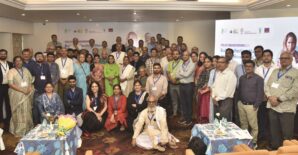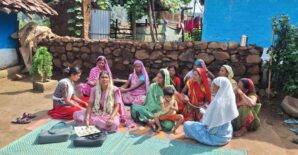Overview | Scientific Committee | Invited Speakers | Sponsors | Conference Summary
Brainstorming Ways for Indian Agricultural Innovation
India’s mood as a nation has been upbeat this past year with talk about pro-poor economic growth and the “Look East” policy in agriculture. This change in outlook comes not only with the entrance of a new government, but also with recognition that two decades of policy reforms and experiments—from liberalizing input markets to guaranteeing employment for the rural poor—have influenced rural livelihoods and agricultural sector growth potential in many ways, both intended and unintended. Decisionmakers in government, business, and civil society see this, and many are looking for fresh analysis on productivity growth trends, returns to farming, and social and economic welfare in rural India.
With that in mind, The Institute of Economic Growth (IEG) and the International Food Policy Research Institute (IFPRI) convened an international conference on “Innovation in Indian Agriculture: Ways Forward” on December 4-5 at the India International Centre here in New Delhi. The conference brought some creative minds together to explore innovative solutions to accelerate development in India’s agricultural sector through productivity growth, higher returns to farming, acceleration of poverty reduction, and the improvement of social and economic welfare in rural India.
Participants and speakers were drawn from a rich mix of backgrounds: senior officers and advisors from policymaking circles, analysts from the policy research community, representatives of farmer and civil society organizations, and executives and entrepreneurs from crop science and agribusiness concerns. As an international convening, the event sat leaders from India on the same dais as foreign scholars with keen interests in the state of Indian agriculture and its place in the world.
Many came away from the event with a keen sense that there is great opportunity still untapped in Indian agriculture. Clearly, there are exciting things afoot in India’s high-value commodity sector, in supply chain development, and in export markets. There is also a lot of growth in input markets, from improved seed for farmers to small-scale mechanization designed to accommodate decreasing labor availability in rural India.
Equally, many came away with questions about whether India is heading rapidly to a complete structural transformation in agriculture. While the notion of a “transformation” is stylistic at best, it does give pause for thought about India’s growth path. Will India follow the experience of other, more developed countries in North America, Europe and East Asia? Will India see change in key economic indicators that herald a true transformation: a higher capital-to-labor ratio underlying agricultural production, a higher marginal productivity of labor, total factor productivity growth, sustained agricultural GDP growth, and rising rural incomes? Will labor move off the farm in substantial numbers to look for new opportunities in non-farm rural employment and enterprises, or in India’s expanding metropolitan areas? Will rural poverty, malnutrition, and deprivation decrease with rising incomes?
For sure, many of these changes are already in motion, and indicators seem to be pointing in the direction of some sort of transformation. But it may also be a long, ungainly process without the right policy interventions. That means more than just passing new bills into law or handing down new directives and ordinances. It means withdrawing policies that are no longer performing as originally intended (for example, grain procurement for the public distribution system), evaluating the impact of recently introduced policies (plant variety protection rights to encourage innovation in the seed industry), strengthening the capacity of line departments to implement policy (for example, local and state departments responsible for providing sanitation, hygiene, nutrition, and health services), and setting the right tone for thoughtful policy design and execution (for example, determining the role for advanced scientific applications in food and agriculture).
The conference highlighted research on the impacts of past reforms in Indian agriculture; structural changes in production, consumption, and demand; resource degradation and climate change, as well as policy analysis of options for Indian agriculture going forward. Options mooted drew on evidence on agricultural development from India’s own rich experience as well as from other countries and regions.
Headlining the conference were Kirit S Parikh, chairman at Integrated Research and Action for Development, and Ashok Gulati, former chairperson, Commission on Agricultural Costs and Prices (CACP), and currently at the Indian Council for Research on Indian Economic Relations (ICRIER). Dr. Gulati took time on the dais to give his vision of key reforms necessary for Indian agriculture, including the streamlining of the myriad ministries dealing with agriculture-related issues—ranging from food to fertilizer to agriculture itself—into one single ministry. He even had time to exchange views with his successor at the CACP, Ashok Vishan Dass.
From this point forward, there was no scarcity of innovative ideas at the conference. Meetu Kapur from the Confederation of Indian Industry chalked out several creative solutions for investment in Indian agriculture, while Bina Agarwal from IEG and the University of Manchester offered several solutions designed to address land tenureship issues in India’s rural land markets. Abhijit Sen, former member of the Planning Commission, similarly emphasized the need for a better institutional architecture to encourage scientific advancement and draw new investment into Indian agriculture. Nitin Desai from IEG gave a resoundingly positive vision of Indian agriculture to the year 2030, complete with a rich description of the impact that creative policy and investment choices could have on rural welfare, agricultural productivity, and the Indian economy as a whole.
But enthusiasm for innovative solutions was, at points, tempered by tough analytical assessments of Indian agriculture’s current trajectory. Several speakers took aim at inefficiencies in the agricultural sector and attributed recent growth trends to the effects of weather and real prices that signal that much more needs to be done to sustain higher rates of agricultural GDP growth. These issues were sized up by several speakers, including Uma Lele, a renowned scholar and chairperson of the Conference Scientific Committee, Mr. Changal Reddy, the president of the Federation Indian Farmers Association, Madhur Gautam from the World Bank, and Ramesh Chand from the National Centre for Agricultural Economics and Policy Research.
Others tackled the complex issue of malnutrition in India with an eye-opening discussion of why the levels and trends of malnutrition in India demand urgent attention, and how government policy can affect rapid change. William Masters from Tufts University, J.V. Meenaskhi from the Delhi School of Economics, and Purnima Menon from IFPRI left their audience with much hard thinking to do.
A similar punch was later delivered on the topic of climate change adaptation by Pramod Aggarwal from the Climate Change Agriculture and Food Security Program; Travis Lybbert, University of California, Davis, California; and Patrick Ward from IFPRI.
Of course, what happens in the tea breaks is as important as what happens on the dais. This conference offered participants ample space to exchange ideas and forge partnership. Heard in the corridors were intense discussions around a range of important issues in India: input subsidies, land tenure security, foreign direct investment in food and agriculture, the National Food Security Act, biotechnology, R&D priorities, the Agricultural Produce Market Committee (APMCs) Acts, micronutrient malnutrition, and gene patenting.
There were strong opinions and heated debates on occasion, but also mutual respect for divergent opinions. And emerging from this conference was a strong call for better, more actionable evidence on innovative solutions that can take Indian agriculture forward.



